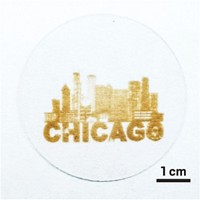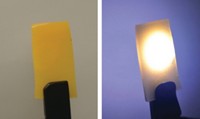Advertisement
Grab your lab coat. Let's get started
Welcome!
Welcome!
Create an account below to get 6 C&EN articles per month, receive newsletters and more - all free.
It seems this is your first time logging in online. Please enter the following information to continue.
As an ACS member you automatically get access to this site. All we need is few more details to create your reading experience.
Not you? Sign in with a different account.
Not you? Sign in with a different account.
ERROR 1
ERROR 1
ERROR 2
ERROR 2
ERROR 2
ERROR 2
ERROR 2
Password and Confirm password must match.
If you have an ACS member number, please enter it here so we can link this account to your membership. (optional)
ERROR 2
ACS values your privacy. By submitting your information, you are gaining access to C&EN and subscribing to our weekly newsletter. We use the information you provide to make your reading experience better, and we will never sell your data to third party members.
Materials
Polymers Brighten Hopes For Visible Light Communication
Photonics: Two semiconducting organic polymers give off a pleasant white light that simultaneously carries data at high speed
by Mark Peplow
February 12, 2015

Today nearly all computers, tablets, and cell phones have Wi-Fi capabilities, receiving and transmitting data over a range of radio frequencies. But a burgeoning technology known as visible light communication could someday carry those data in the same light that illuminates a room using “smart lighting.” Now a tag team of semiconducting organic polymers is bringing that dream one step closer. When excited with a light-emitting diode (LED), the polymer pair helps to create white light that can be rapidly switched on and off to encode information (ACS Photonics 2015, DOI: 10.1021/ph500451y).
Streaming high-definition movies and online gaming are straining the capacity of many Wi-Fi networks, and precious little space is left for additional transmission channels in the radio and microwave spectrum. By coating blue LEDs with phosphors to create white lights, researchers hope to provide an alternative data highway that combines illumination and communication. Pulsing too quickly to see with the naked eye, the lights could relay large volumes of data through a sequence of flashes. The dual-purpose LEDs could also lower costs and save energy compared with separate lighting and data systems, says Graham A. Turnbull, a physicist at the University of St. Andrews, in Scotland.
Turnbull and his colleagues are aiming to develop LEDs that can send gigabits of data per second and offer a natural white light. Producing a device that satisfies both of those criteria poses a tough challenge. For example, an inorganic phosphor used to coat the blue LEDs may absorb some of the blue light and reemit it as yellow light. But the white light from these devices would be poor at highlighting some colors, making red objects look muddy brown. Even worse, these inorganic phosphors have relatively long photoluminescent lifetimes—taking microseconds to switch from on to off—unacceptably slow for encoding data.
So the team wondered if a pair of organic polymers might work as an alternative to the phosphors. Organic semiconducting polymers tend to switch on and off more quickly and have broader emission spectra that help improve light quality. Also, they are easy to blend and coat onto an LED. Turnbull and his colleagues used a poly(p-phenylenevinylene) derivative, BBEHP-PPV, that absorbs some of the blue light from an indium gallium nitride LED and reemits it as green. Another PPV derivative, MEH-PPV, then steals some energy from the BBEHP-PPV and emits it as orange-red light.
Together, the polymers produce a higher quality white light than previous efforts at smart lighting. “It’s in the right ballpark, comparable to conventional LED lighting,” Turnbull says. Crucially, the polymers also have a photoluminescent lifetime of less than 1 nanosecond, enabling rapid switching. The team’s proof-of-principle device sent data at 350 megabits per second over a distance of 5 cm with minimal errors, a rate 35 times faster than a commercially available inorganic phosphor.
“What they are doing is really impressive,” says Guglielmo Lanzani, a photonics researcher at the Italian Institute of Technology, in Milan. What’s more, researchers could test plenty of other well-characterized semiconducting organic polymers for their visible-light communication abilities, Lanzani adds.
Turnbull and his colleagues are now tweaking the structure of MEH-PPV to improve its energy efficiency and to make it redder, which would warm the white light’s hue. Turnbull predicts: “Smart lighting is a field that’s going to grow dramatically.”





Join the conversation
Contact the reporter
Submit a Letter to the Editor for publication
Engage with us on Twitter